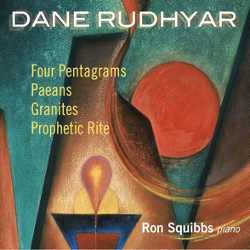|
DANE RUDHYAR
Four Pentagrams; Paeans; Granites; Prophetic Rite
 Reviewed by Robert Reigle Reviewed by Robert Reigle
2014-08-18
Tracks:
1-20. Four Pentagrams (1924-26, revised 1971-74)
21-23. Paeans (1927)
24-28. Granites (1929)
29. Prophetic Rite (circa 1934)
Ron Squibbs, Steinway D piano
Aucourant Records, Aurec-1302
Published 2013
Total time 79:38
www.aucourantrecords.com
Dane
Rudhyar (1895-1985), one of the most unjustly neglected composers, may
finally be getting his due. Acknowledgment of his work seems to
be growing: a couple of excellent websites offer most of his published
writings on music along with some wonderful recordings, and Deniz Ertan
has published the first book, other than Rudhyar’s own, about his
music, ideas, and art (University of Rochester Press, 2009).
During the last century, only a handful of recordings of Dane Rudhyar’s
music appeared, but the new millennium has already seen fine recordings
by Richard Cameron-Wolfe (Furious Artisans, in 2003), Steffen
Schleiermacher (Hat Art, 2004; MDG, 2005), and Richard Zimdars (Albany,
2009). Now comes the world-premiere recording of “Four
Pentagrams,” composed in 1924-26 and revised in 1971-74.
Originally released in 2009 with one less piece, this 2013 reissue adds
another world premiere, “Prophetic Rite” (written circa
1934).
What splendid music! Free-flowing, clusters, ritualistic,
repeated notes, floating tones free from Eurogenetic common-practice
major-minor system, mystical, unique, contemplative, emotional.
Rudhyar’s music sounds like nobody else’s, and yet some of the sounds
demonstrate an ethos that overlaps that of free-thinkers like Edgard
Varese and Henry Cowell. At age 18, Durand published Rudhyar’s
book about Debussy, though they did not include the mystical section of
his manuscript. Rudhyar has influenced a number of composers, in
both the United States and Europe.
In his dissertation on Giacinto Scelsi, Gregory Reish demonstrated the
profound influence Rudhyar had on Scelsi. Both composers delved
into the inner components of tone. One of the vehicles for those
explorations was the idea of bells and gongs, whose sounds are very
complex. In each of the “Pentagrams” and in “Paeans,” as pointed
out in the liner notes by pianist/scholar Ron Squibbs, Rudhyar evokes
these inharmonic sounds. Likewise, Scelsi does so in his piano
compositions and first string quartet. Of course, many composers
have imitated bell sounds with instruments such as the piano, and
Charles Ives called for actual “distant church bells” to be played at
the very end of his third symphony (which can be heard in Harold
Farberman’s recording on Vanguard).
What is unique about Rudhyar’s approach is his profound understanding
of tone. Although completely unremarked in the literature on
“spectral music” (a term coined in the mid 1970s), it was Dane Rudhyar
who had composed the very first spectral score, notating specific
overtones as early as 1922, for the first time in the history of
score-writing! The Musical Quarterly published it in that year as an unpaginated foldout accompanying his article “The Relativity of Our Musical Conceptions.”
The four “Pentagrams” make a complete suite, lasting 56 minutes, whose
individual components gain meaning and power when heard together.
While these are the first recordings of “Pentagrams I, II, and IV,” the
“Third Pentagram” has been recorded three times before, by Michael
Sellers (under Rudhyar’s supervision), Steffen Schleiermacher, and
Richard Zimdars. “Paeans” (1927) and “Granites” (1929) have been
recorded twice before. I like all of the recordings, and Ron
Squibbs’ faster tempos in “Paeans” provide a new and convincing
perspective on that remarkable composition (Squibbs: 5:22; William
Masselos: 7:00; Steffen Schleiermacher: 9:05).
Ron Squibbs’ performances are emotional and powerful, and engineer
Robert Scott Thompson’s recordings of the Steinway D sound luscious
without sacrificing clarity. The album design is beautiful,
featuring insets from, as well as a full image of, Rudhyar’s painting
“Meditation on Power” (1948). This is the way to make an album:
world-premiere recordings, beautiful and meaningful graphics, excellent
sound, extensive and well-written liner notes, passionate performances,
fully packed disc (79:38), and above all, wonderful music. Kudos
to Ron Squibbs for his dedication to Rudhyar’s music, and to Aucourant
Records for investing in a beautiful and perfectly-documented package
in this age of virtual-music delivery.
|

 Reviewed by Robert Reigle
Reviewed by Robert Reigle